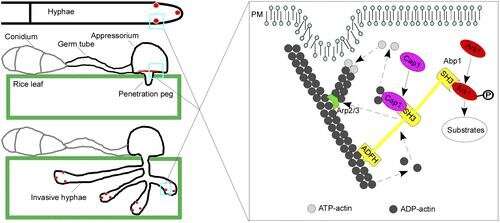Rice blast fungus study sheds new light on virulence mechanisms of plant pathogenic fungi

Rice blast fungus (Magnaporthe oryzae) is a global food security threat due to its destruction of cultivated rice, the most widely consumed staple food in the world. Disease containment efforts using traditional breeding or chemical approaches have been unsuccessful as the fungus can rapidly adapt and mutate to develop resistance. Because of this, it is necessary to understand fungal infection-related development to formulate new, effective methods of blast control.
A group of scientists at Nanjing Agricultural University and Louisiana State University Health Sciences Center examined the fungal cell biology of rice blast fungus pathogenesis and recently published the first systematic and comprehensive report on the molecular mechanism of the actin-binding protein (MoAbp1) that plays a crucial role in the pathogenicity of the fungus.
Through ongoing research, these scientists found that rice blast fungus forms a specialized infection structure that applies mechanical force to rupture the rice leaf cuticle. Once inside the host, the infection proliferates by living off the plant's nutrients. These two processes are enabled by the actin-binding protein (MoABp1) that links an actin-regulating kinase (MoArk1) and a cyclase-associated protein (MoCap1) to an actin protein (MoAct1). These processes are necessary for the growth and perseverance of the fungus.
On a large scale, these findings shed a new light on the eukaryotic cell biology and virulence mechanisms of plant pathogenic fungi. On a smaller scale, these findings could reveal novel approaches or targets for anti-blast fungus management.
More information: Lianwei Li et al, Magnaporthe oryzae Abp1, a MoArk1 Kinase-Interacting Actin Binding Protein, Links Actin Cytoskeleton Regulation to Growth, Endocytosis, and Pathogenesis, Molecular Plant-Microbe Interactions (2018). DOI: 10.1094/MPMI-10-18-0281-R
Journal information: Molecular Plant-Microbe Interactions
Provided by American Phytopathological Society



















